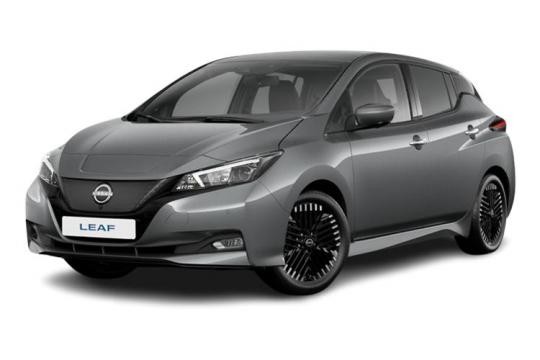Not The Electric-hybrid For You?
Let our friendly experts help you find the perfect electric-hybrid by contacting us today.


The Nissan LEAF has always been a car that divides opinion. Some love this fully electric vehicle for its bold engineering and surprisingly enjoyable driving dynamics, but to date, many other green-minded potential buyers have struggled to make a case for it. But things are changing. For the latest model year, the brand has introduced a slightly smarter look. Plus value has been prioritised across the line-up.


From
£492.36 inc VAT
Initial rental: £4,431.24 inc VAT
48 months, 10000 annual mileage,
RRP Value £28,940.00 inc. VAT

From
£505.06 inc VAT
Initial rental: £4,545.50 inc VAT
48 months, 10000 annual mileage,
RRP Value £30,440.00 inc. VAT

From
£515.50 inc VAT
Initial rental: £4,639.46 inc VAT
48 months, 10000 annual mileage,
RRP Value £28,440.00 inc. VAT

From
£410.30 exc VAT
Initial rental: £3,692.70 exc VAT
48 months, 10000 annual mileage,
P11D £28,940.00

From
£420.88 exc VAT
Initial rental: £3,787.92 exc VAT
48 months, 10000 annual mileage,
P11D £30,440.00

From
£429.58 exc VAT
Initial rental: £3,866.22 exc VAT
48 months, 10000 annual mileage,
P11D £28,440.00
Summary
Has this car's time finally come? Probably not quite yet, but the improvements Nissan continues to make will open up a much larger market for it. In developing this second generation model, the Japanese maker has clearly listened to customer feedback. The biggest issue of course was driving range, but as well as enhancing that with the alternative 'e+' variant, the brand has also added a package of technology that will make buyers feel that they're at the cutting edge of automotive technology. Of course, some of the previous issues still remain. The car is still quite expensive to buy in the 'e+' form you'll probably want, the looks will divide opinion and you won't even be able to consider it unless you have off-street overnight parking. Little by little though, all-electric motoring is widening its customer reach. And, as it's always been, the LEAF remains right at the forefront of that change.
Background
You're probably already aware of this - but it bears repeating: the Nissan LEAF is the world's best selling electric vehicle. You might think that would equate to sales in their tens of millions. Actually, the truth is that following its launch back in 2010 and throughout a production life that lasted nearly eight years, the first generation version of this battery-powered Nissan shifted 283,000 units. Worldwide. So we really aren't talking massive numbers here. That says less about the LEAF - a design we've always thoroughly respected - and more about the slow global take-up of battery-powered cars, which continues to lag behind industry predictions. Mostly, that's been because of the restrictions that fully battery-powered vehicles put on driving range, though that's something that's changing as automotive electric technology changes. It's certainly developed enough to make this second generation LEAF well worth another look if you couldn't quite justify the purchase of its predecessor. Particularly in this latest form.
Driving Experience
Nissan wants to tell us about the more appealing 'Canto' sound the latest version of this model makes. But here we're going to start by dealing quickly with the first thing you'll want to know about: driving range. We remember vividly setting off in the first generation LEAF model back in 2010 and struggling to get much more than 60-70 miles out of it between charges. With this second generation design, Nissan claims a homologated WLTP driving range of 168 miles from the standard 39kWh model - or 239 miles (WLTP) from the alternative 'e+' version with its 59kWh battery. Even if you think in terms of a 'real world' driving range being about two-thirds of those total figures (which is our experience anyway), you can't deny that these readings represent an impressive improvement, representing a 50% increase over the final version of the original generation model. The 40kWh lithium-ion battery that virtually all LEAF models still use produces 110kW (which equates to 148bhp) and 320Nm of torque - making the LEAF feel quite fast from a standing start: Nissan say that the 0-62mph time is about 9.8s. In the past with LEAF models, the amount of retardation you got when lifting off the throttle meant that the brake pedal was something you rarely needed to use. With this second generation model, you'll hardly need it at all thanks to 'e-Pedal' technology that can bring the car to a complete stop when you come off the accelerator. The key news here though is that the larger 62kWh battery 'e+' version of this car has now been priced much more accessibly - and this uprated model's longer 239 mile driving range could be key in convincing potential buyers who might otherwise be swayed by longer-running EV rivals in this segment.
Design and Build
Not too much has changed visually with this refreshed LEAF: redesigned 16 and 17-inch alloy wheels, a refreshed palette of colours and a revised Nissan brand badge - that's about it. Otherwise, it's all as you were. There are two routes to styling an all-electric car. Either you make it look exactly like a conventionally-engined model, as with, say, the Hyundai Kona Electric and the Kia Niro EV. Or you go for something overtly futuristic, as Nissan did with the first generation LEAF model. That approach continued on with this second generation design, which gets a sleek body featuring a flat floor, a sharp nose and an aggressively tapered rear end. There are though, familiar cues from more ordinary Nissan models - things like the company's signature 'V-motion' front grille, the 'boomerang'-style lights and the kicked-up rear shoulder line for example. The MK2 model shape is certainly slippery; Nissan says it has a drag coefficient of 0.27Cd. And the whole structure's stiff too, torsional rigidity having improved by 15% over the previous generation design. Importantly, interior practicality is much like any combustion-engined family hatch, notably in terms of boot space, which is rated at 435-litres. The designers have also tried to give the cabin quite a premium feel, with smart trim materials and a smart look for the 7-inch centre-dash infotainment touchscreen. To remind you of this car's eco-friendly remit, there's vibrant blue stitching on the seats, the dashboard and the steering wheel. Two adults can fit comfortably across the back seat - and three could fit at a push. Out back, there's a 436-litre boot.
Market and Model
Most LEAF models feature the 39kW battery and those are priced quite affordably in the £29,000 to £32,000 bracket. There are 'Acenta', 'N-Connecta' and 'Tekna' trim levels. The longer range 59kWh battery 'e+' models now start more accessibly than used to be the case, priced from around £35,000 and available in 'N-Connecta' and 'Tekna' trims, with pricing up to around £36,500. The vast majority of customers will take ownership using some kind of finance scheme. These can make the prospect of running this Nissan look quite affordable but when all's said and done, this car still remains a relatively expensive way of showcasing your eco-friendly world outlook to the neighbours. You'd certainly have to run it for far longer than most owners will want to if you're to get back the premium you've paid over what a comparably-sized Focus-class family hatchback would have cost. Part of this is because Nissan feels the need to offer even the most basic versions of this car with lots of sophisticated equipment. This, for example, is the only model the company makes which features its 'ProPilot' autonomous driving technology as standard, this a set-up which on motorways, can steer, brake and accelerate for you. There's also a 'ProPilot Park' system which will take control of all steering, acceleration, braking and gear selection to automatically guide the car into a parking slot. Inside, every variant gets a 7-inch colour centre-dash infotainment touchscreen featuring 'Apple CarPlay'/'Android Auto' smartphone-mirroring technology. Plus there's a package of 'Safety Shield' features familiar from other Nissan models.
Cost of Ownership
As the UK's electric car charging infrastructure becomes more advanced, it's becomes obviously much easier to make a case for cars like this. Quite a number of 50kW charging points are springing up in our cities and once you locate one of these, you'll be able to regularly re-charge your LEAF from empty to 80% capacity in just 40 minutes. As for domestic charging, well obviously if you plug into an ordinary three-pin plug socket - as you might have to do if you're out and about, say visiting relatives - re-charging still takes ages, though you can get quite a lot of it done with an overnight charge. Of course, for home re-charging, you'll want to fit a proper re-charging wallbox. Nissan can sell you a 7.5Kw domestic charging point that will be able to fully charge the car from empty in five and a half hours. Use a more normal 6kW charger and the replenishment time rises to about eight hours. A nice touch is the inclusion of an LED inspection light in the car's charging point so that owners won't have to rely on street lighting to connect their cars to an electric source at night. Add these quick charging times to the increase in driving range that this current generation LEAF model has delivered over its original predecessor (a WLTP-rated figure 168 miles is quoted for the standard 39kWh model) and LEAF ownership could now add up for people who previously couldn't have justified it. To further strengthen its case, Nissan will want EV folk to consider the alternative 'e+' model, which uses a 59kWh capacity battery and is supposed to be able to extend that WLTP range to 239 miles.
You need to have an account to add vehicles to your showroom. Click the button below to login or to create a new account.
Register or Log In